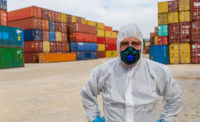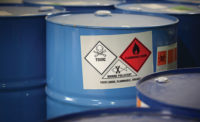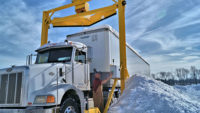Citing a forecast from the Federal Highway Administration, the Association of American Railroads (AAR) reported in July 2019 that total railroad freight shipments in the United States will rise from 17.8 billion in 2017 to an estimated 24.1 billion in 2040, an increase of 35%. A good portion of this growth is being driven by the historically high levels of oil and natural gas that is being produced and transported in the U.S, creating a need for more so-called “crude-by-rail” shipping.
Since crude oil and natural gas are considered hazardous materials, there are now approximately 3.1 billion tons of hazardous materials – which also commonly include chlorine, anhydrous ammonia, ethylene oxide and sulfur dioxide (SO2) – transported via long-haul rail in the U.S. each year. Despite this growth in long-haul rail transport, railroads remain one of the safest ways to transport both hazardous and non-hazardous materials.
According to Federal Railway Administration’s (FRA) 2018 rail-safety data, the overall rates for train accidents, equipment-caused accidents, track-caused accidents, derailments and employee injuries, per million train miles traveled, have declined as much as 26% since 2009, depending on the category. More specifically, between 2008 and 2018, the hazardous material (hazmat) accident rate fell by 48%. In fact, in 2018 more than 99.999% of rail hazmat shipments reached their destination without a release caused by an incident.
These heartening statistics are much more than a happy coincidence. They are the manifestation of the railroad industry making a strong commitment to ensuring that its infrastructure and rolling stock are up-to-date and in top working order, that all regulations regarding hazmat hauling are steadfastly observed and that its employees are properly trained.
Accidents can still happen
The railroad industry has a goal of one day becoming accident-free. If this level of operational nirvana is ever to be achieved, railroad operators must be familiar with the risks that are inherent in the handling of hazardous materials – and the ways that they can lessen the chances that an incident involving the release of hazardous materials will occur.
There are three primary potential risks every time a train laden with hazardous materials pulls away from the depot:
Accident: Accidents are the hardest thing for railway operators to protect against since their rate of occurrence can be capricious and they are often caused by external factors that are entirely out of the operator’s control. These can range from an automobile or truck that has stopped illegally on the tracks to a tree that may have fallen across the tracks during a passing storm.
The remaining two risks fall into the category of “non-accidental releases,” or NARs. An NAR is the unintentional release of hazardous materials during transportation, which includes material loading and unloading, that is not caused by an accident. There are two basic types of NARs:
- Mechanical Failure: This category encompasses all leaks and other releases from malfunctioning or improperly secured pressurized railcar pressure-relief devices, valves, couplings, hoses, fittings and tank shells.
- Operator Error: Human beings are fallible creatures that are susceptible – no matter their level of conscientiousness or training – to making mistakes. So, all railroad technicians must take every precaution necessary to ensure that every coupling is attached properly and every valve is closed properly before, during and after every railcar loading or unloading.
A friend for first responders
Despite the next-generation design and operation of railcars and their ancillary components, the high-level training that rail personnel receive, the attention paid to guaranteeing that the railway infrastructure is in good working order and stricter regulations governing the transport of hazardous materials, the next hazmat release incident is always looming. To ensure that the sometimes inevitable doesn’t become the next catastrophic, headline-generating hazmat-release incident, the manufacturers of railcar equipment have developed Emergency Response Kits (ERKs) that are marketed to fire departments, emergency-repsonse contractors and railway dangerous goods officers, or any other organizations that employ first responders who are tasked with responding to railroad accidents or NARs.
One of the companies that has taken the lead in the development of ERKs is Midland Manufacturing, Skokie, IL. Its B-240/B-243 Emergency Response Kit has been developed to give emergency responders three easy-to-use cover assemblies and a carrying case that contains all of the tools and parts needed to quickly and safely cap hazmat leaks emanating from the top of pressurized railcars in the event of an accidental or NAR release incident.
A typical ERK consists of a toolbox containing a broad range of tools and replacement parts; cover cans of five different sizes that are used to cap a leaking valve or fitting, along with corresponding gaskets; and a bridge that is used to secure a cover can to the railcar’s manway cover plate. Knowing the importance of the ERK’s components being able to perform reliably in high-leverage situations, all of the tools are highly engineered and designed to be durable no matter the pressures, product flows and general abuse they are subject to during a hazmat-release incident.
Like any product, the user of an ERK is only as proficient in its use as the level of training he or she receives. With that in mind, the providers of ERKs offer training classes and videos that are formatted to make the user capable of performing confidently during the most dangerous release incidents. In fact, it is recommended that all first responders practice using the components in the ERK at least twice a year and, if possible, train with an actual hazmat railcar as a way to better familiarize themselves with the railcar’s components and where things can go wrong. The ultimate goal is for first responders to feel as comfortable as possible with the ERK and its components and capabilities long before they ever have to use it.
Conclusion
Despite the significant growth in volume over the past decade, the safety record of hazardous-material transport via railroad is great – and getting better every year. Still, accidents (or “non-accidents”) can and do occur. When these unfortunate incidents do happen, it is imperative that first responders possess the training and equipment required to prevent a catastrophe. Manufacturers of railcar equipment have responded with the creation of ERKs that possess the tools needed to halt a hazardous-material release as quickly as possible, knowing that the safety of the environment, surrounding communities and, of course, the first responders themselves hangs in the balance.



